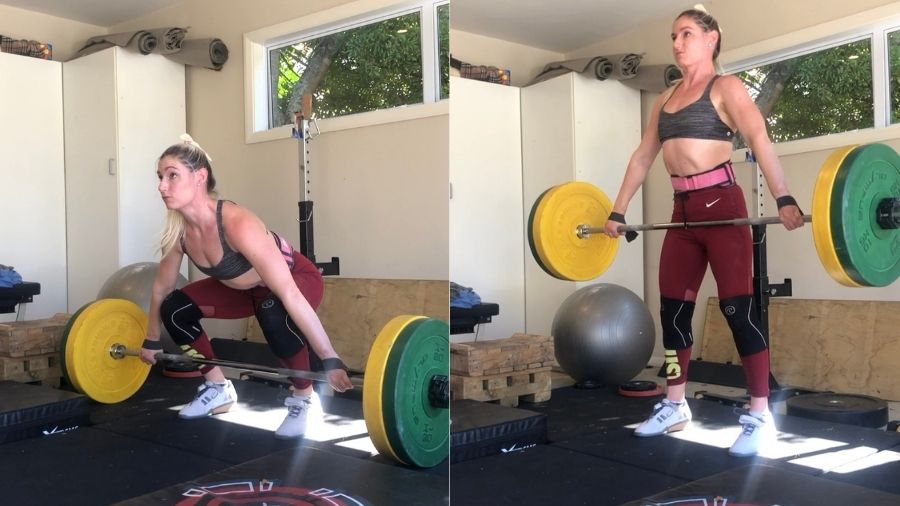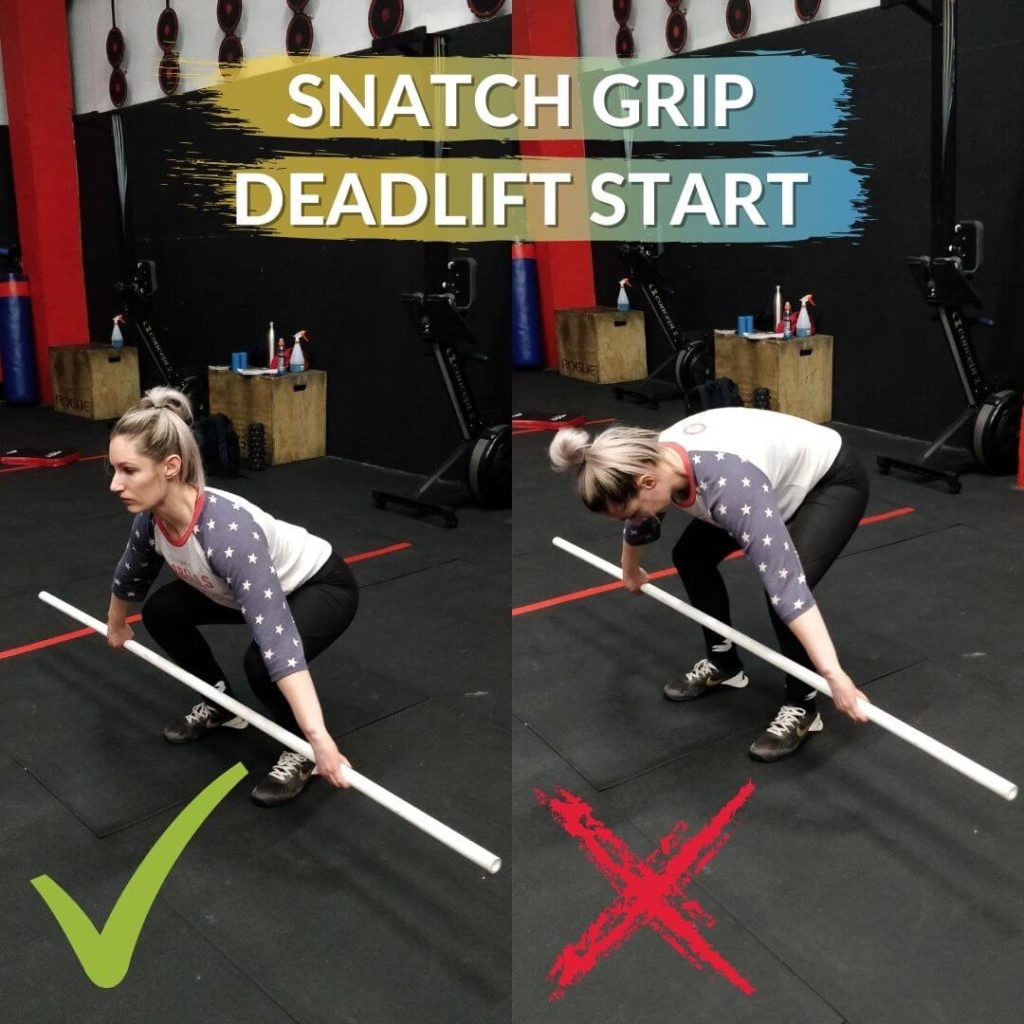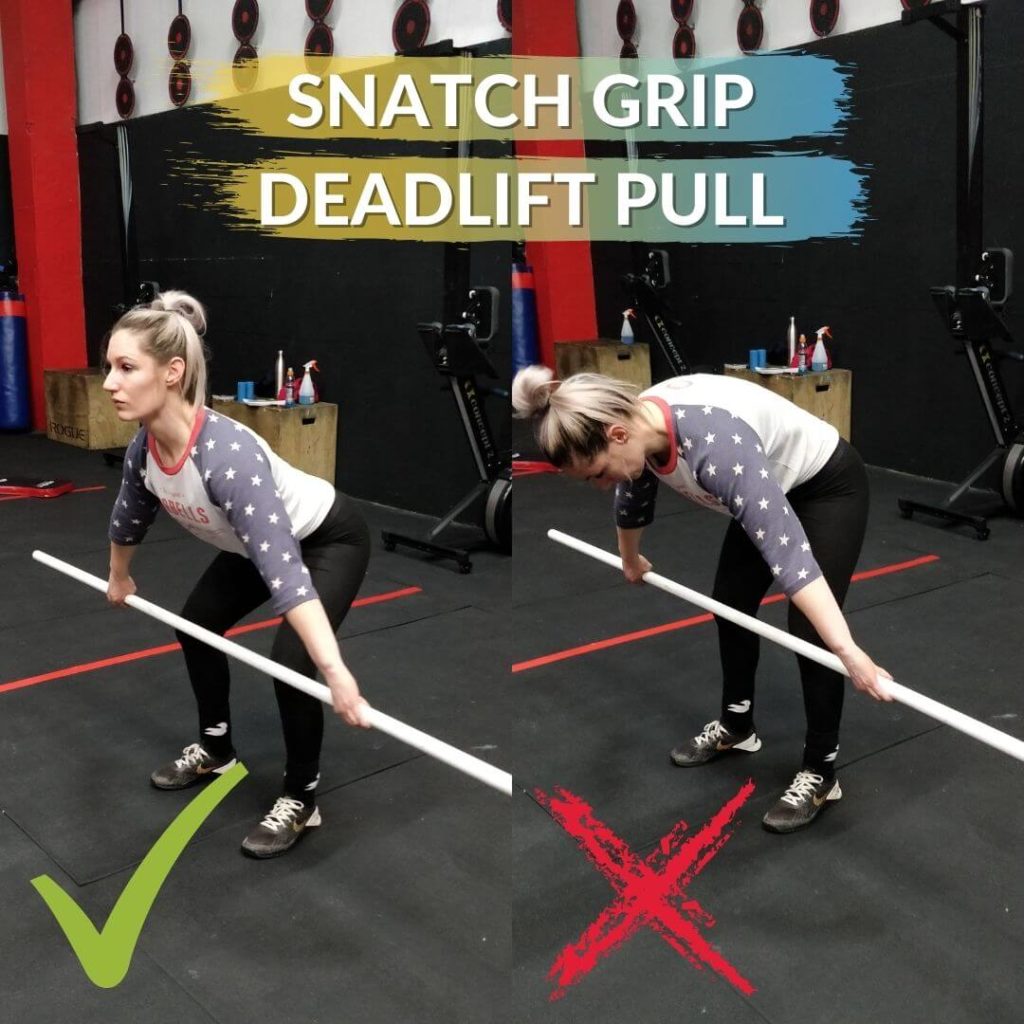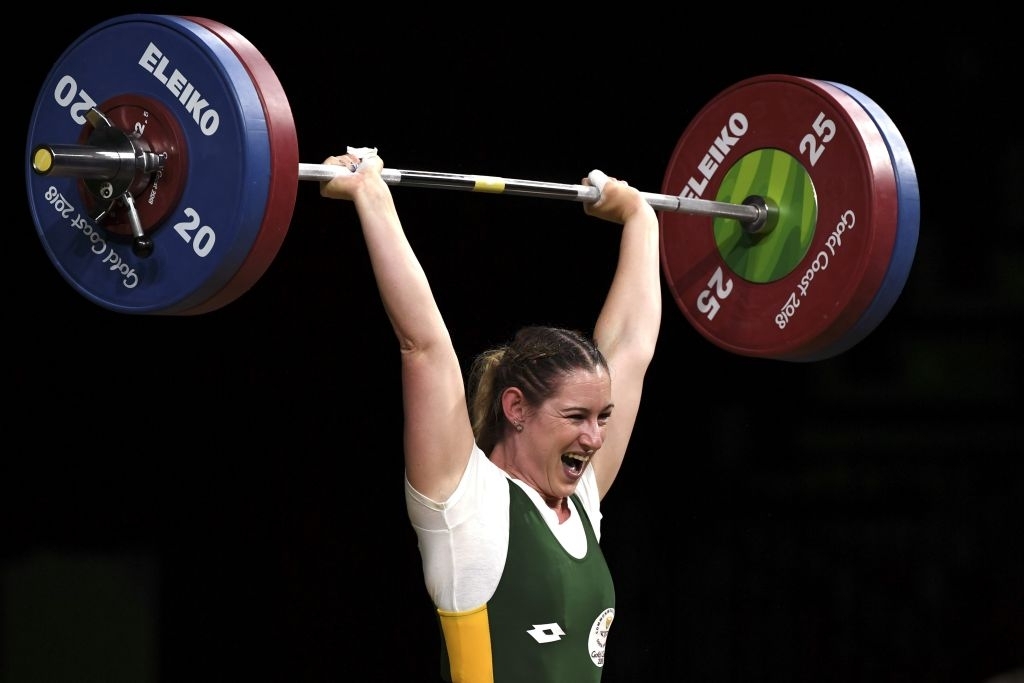In weightlifting, you will find that even though there are two classical lifts you do in competition, many assistance exercises go into building technique and strength for those two movements. One of them being the snatch grip deadlift.
The snatch grip deadlift will help you build overall strength in your snatch and work on the bar path from the ground to the hip the same way as the snatch.
If you thought the snatch grip deadlift was reserved for Powerlifters, you’ll see why it’s a vital exercise for Olympic Weightlifters.
Table of Contents
What Is The Snatch Grip Deadlift?
The snatch grip deadlift is a deadlift from the ground to the hip, similar to the clean grip deadlift, except your stance and grip will be precisely the same as you would do a snatch. Meaning your grip will be wider than a traditional deadlift.
Olympic Weightlifters use the snatch grip deadlift to strengthen the pull for the snatch. It allows you to load the correct positions under loads much heavier than you’d snatch or snatch pull.
Snatch Grip Deadlift Muscles Worked
The muscles worked in the snatch grip deadlift will predominantly be the upper back, spinal erectors, glutes, quads, and hamstrings. It’s close to a full-body exercise, so you can use it to develop a thick physique even if you’re not a Weightlifter.
Snatch Grip Deadlift Benefits

Reinforce The Correct Bar Path
The snatch grip deadlift is a great way to train the bar path from the floor to the hips in how the bar should be moving in the snatch.
Breaking down the movement in segments can be hugely beneficial to learning where the body and the bar should be at different phases in the pull.
Develop Strength For The Snatch
Building strength in the movement from the ground to the hip will make a massive difference in your snatch. The snatch grip deadlift is the foundation of the snatch as the bar will start from the ground and move upwards and most lifts go wrong before the bar even passes the knees. That is why it is so important to be strong in those positions.
Develop Patience For The Snatch
Learning to have patience from the ground in the snatch grip deadlift will set you up for success by being super aggressive later on in the pull. By being patient with the ground, you can learn not to rush the movement.
You learn to feel the position and drive the legs into the ground. Patience from the ground also means you will have more control over your movement. When you rip and grip the bar from the floor, you will waste so much energy and strength, which will ultimately cause the upper back to round.
Strengthen Your Grip
The snatch grip deadlift isn’t always the most comfortable on your grip, but it will build grip strength over time which is great to have, especially when you start doing more volume cycles with heavier weight. Having a good grip means you will be able to keep the arms relaxed and focus on moving the bar correctly, and not worrying about if your grip will last.
How To Snatch Grip Deadlift For Weightlifting
Grip Width
The grip width will be the exact grip you would have for the snatch. If you do not know where your snatch grip width is, you can test it by standing up with the bar at the hips. You want to make sure you are standing tall with the lats activated.
The bar should be sitting in the hip crease, below the hip bones, and above the pubic bones. That will be where you will grip the bar for the snatch, and the snatch grip deadlift.
You can then grip the bar with a hook grip, or more advanced level weightlifters will often perform the snatch grip deadlift with straps.
Starting Position

The starting position will be with your feet hip-width or slightly wider than hip-width—the same stance as what you would have in the snatch. You will then grip the bar with a hook grip. Make sure you have good posture with the lats activated and a big chest.
Shoulders, elbows, and wrists should be in line and stacked over each other as much as possible. Ensure you are nicely over the bar and the foot pressure is evenly spread (pressure from the entire foot).
The bar should be sitting over the mid of the foot. The position of the bar could vary slightly depending on your limb length.
The Pull

The next step is the pull/deadlift off the ground. You want to make sure the pressure is over the whole foot. You will then start by driving your legs into the ground, staying over the bar as much as possible, and keeping the back nice and straight with a good posture.
Once the barbell reaches the knees, you want to pull the knees slightly out of the way and keep the bar as close as possible to the body.
You do not have to grate the bar against your shins and thighs. Once you pass the knees with the bar, you will extend up into a tall position without extending onto the toes. The bar should end at the hips in the same position as you would with the snatch.

Common Snatch Grip Deadlift Mistakes
Letting The Hips Rise First
Lifting the bum first instead of staying over the bar and driving with your legs and keeping the back angle over the bar as long as possible will cause you not to generate the same power.
Lifting the bum first while you pull can also throw your momentum off by putting your weight on your toes instead of the whole foot. You will also be working a whole lot more hamstring than using the strength from your quads, hamstrings, and glutes.
It’s a poor technique, which can mess up how you move in the snatch.
Having Weight On The Heels
With the snatch grip deadlift, it is essential to push your whole foot into the ground to get the most strength and power out of the movement. When you drive up with the heels into the ground and the toes or ball of the foot lifts, you will extend backward instead of straight up.
Hyperextending in the tall position may not make a massive difference in the deadlift itself, but it will negatively impact when you do this exercise to improve your snatch.
Having Weight On The Toes
On the flip side, if the pressure is on the front of the foot or toes, your momentum will end being forward instead of driving straight up to generate the most amount of strength and power in the movement.
Rounding The Upper Back
Rounding your upper back in snatch deadlift or having poor posture can tremendously affect how you move. You might be able to deadlift a significant amount of weight, but you will have no carry-over to the snatch. You will do more damage than good when the upper back rounds.
It’s essential to keep a good posture throughout the whole movement.
Hyper Extending The Back When Finishing
Many athletes from a CrossFit background tend to hyper or overextend in the tall position when they have picked the barbell up. Over or hyperextension of the back is very bad for your lower back and doesn’t have an excellent carry-over to the snatch. You need to drill the movement with good form, standing up tall and moving the same way as you would with the snatch.
How Heavy Should You Snatch Grip Deadlift?
Generally, intermediate and advanced weightlifters will work between 90-130% of their 1RM snatch. You can snatch grip deadlift heavier than your classical snatch.
However, if you are a beginner athlete and are doing this movement to learn the technique, I would stick with very low percentages to just train bar path.
Snatch Grip Deadlift Variations
Snatch Grip Deadlift From Blocks
Also, be called a partial rep deadlift. The from-block snatch grip deadlifts are excellent for training positions where you want to get stronger.
There are different heights of the blocks you can use in this exercise, and generally, they are the high blocks (bar will be either at the high part of the thigh or hip), average block height (just above the knees), and the low blocks (below the knee).
Snatch Grip Deadlift From Platform/Deficit
Snatch grip deadlift from the platform is a great way to build more strength by adding a range of motions and increasing the pull length. To do the snatch grip deadlift from the platform, you will be adding a small block under your feet or some plates.
This is a great exercise if you want to learn to pull longer in your snatch.
Snatch Grip Deadlift With A Pause
Snatch grip deadlift with a pause is a great way to build strength with added time under tension. It’s also a great way to teach beginner athletes where the bar should be in different phases of the lift.
Athletes typically pause below the knee, above the knee, and at the high thigh, or even all three, depending on your program.
Tempo Snatch Grip Deadlift
Tempo snatch grip deadlift is another variation to build strength with time under tension. Tempo means moving slowly, and the two variations are often tempo pull or tempo lowering of the bar. Both are very effective for building strength in the movement.
When performing the tempo snatch grip deadlift, you will often see a tempo of 3-6 seconds down or up.
Snatch Grip Romanian Deadlift
Snatch grip Romanian deadlift is an excellent exercise for building muscle in the posterior chain, including the erector spinae and glutes. You will do the snatch grip Romanian deadlift the same way as a traditional Romanian deadlift, with the only difference being the grip.
By doing a snatch grip Romanian deadlift, you will increase the distance the bar can travel by having a wider grip.
Snatch Deadlift Shrug
The snatch grip deadlift shrug is the same as a standard snatch grip deadlift, except now you will end the movement on top with a shrug. You want to do this movement as fluently as possible to train the brain to do the same action in the snatch.
The snatch grip deadlift shrug is a great strength-building movement with the added shrug to build trap strength, back strength, and leg strength.
Summary
The snatch grip deadlift is an epic variation to add to your program when you want to switch up the movements from your clean grip deadlifts or even pulls. This movement is fantastic for building strength in the snatch if done correctly.

